| Listing 1 - 10 of 14 | << page >> |
Sort by
|
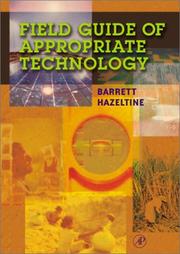
ISBN: 1280961368 9786610961368 0080469809 0123351855 9780123351852 9781280961366 9780080469805 6610961360 Year: 2003 Publisher: Amsterdam Boston Academic Press
Abstract | Keywords | Export | Availability | Bookmark
 Loading...
Loading...Choose an application
- Reference Manager
- EndNote
- RefWorks (Direct export to RefWorks)
This book is an all-in-one ""hands-on guide"" for nontechnical and technical people working in less developed communities. It has been developed and designed with a prestigious team of authors, each of whom has worked extensively in developing societies throughout the world.This field guide includes:· Step-by-step instructions and illustrations showing how to build and maintain a vast array of appropriate technology systems and devices· Unique coverage on healthcare, basic business and project management, principles of design, promotion, scheduling, training, microlendi
Appropriate technology. --- Appropriate technology--Developing countries--Handbooks, manuals, etc. --- Developing countries. --- Handbooks, manuals, etc. --- Appropriate technology --- Engineering & Applied Sciences --- Technology - General --- Alternative technology --- Appropriate technologies --- Soft technology --- Technology
Book
ISBN: 0813586526 0813586534 9780813586533 9780813586526 9780813590851 081359085X 9780813586519 0813586518 9780813586502 081358650X 081359085X Year: 2017 Publisher: New Brunswick, NJ
Abstract | Keywords | Export | Availability | Bookmark
 Loading...
Loading...Choose an application
- Reference Manager
- EndNote
- RefWorks (Direct export to RefWorks)
Most Americans take for granted much of what is materially involved in the daily rituals of dwelling. In Dwelling in Resistance, Chelsea Schelly examines four alternative U.S. communities-"The Farm," "Twin Oaks," "Dancing Rabbit," and "Earthships"-where electricity, water, heat, waste, food, and transportation practices differ markedly from those of the vast majority of Americans. Schelly portrays a wide range of residential living alternatives utilizing renewable, small-scale, de-centralized technologies. These technologies considerably change how individuals and communities interact with the material world, their natural environment, and one another. Using in depth interviews and compelling ethnographic observations, the book offers an insightful look at different communities' practices and principles and their successful endeavors in sustainability and self-sufficiency.
Sustainable living --- Appropriate technology --- Alternative technology --- Appropriate technologies --- Soft technology --- Technology --- Ecological living --- Green living --- Living, Sustainable --- Alternative lifestyles --- Environmentalism --- Green movement --- Social aspects.
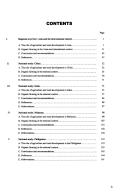
ISBN: 1417548711 9781417548712 9211201381 9789211201383 Year: 2005 Publisher: [Place of publication not identified] United Nations Publications
Abstract | Keywords | Export | Availability | Bookmark
 Loading...
Loading...Choose an application
- Reference Manager
- EndNote
- RefWorks (Direct export to RefWorks)
Organic farming --- Rural development --- 631.147 --- 631.147 Biotechnic, ecological farming (for alternative, intermediate and soft technology). Organic farming and farms --- Biotechnic, ecological farming (for alternative, intermediate and soft technology). Organic farming and farms --- Community development, Rural --- Development, Rural --- Integrated rural development --- Regional development --- Rehabilitation, Rural --- Rural community development --- Rural economic development --- Agriculture and state --- Community development --- Economic development --- Regional planning --- Ecological agriculture --- Organic agriculture --- Organic crops --- Organic cultivation --- Organic production of crops --- Organiculture --- Regenerative agriculture --- Agriculture --- Citizen participation --- Social aspects
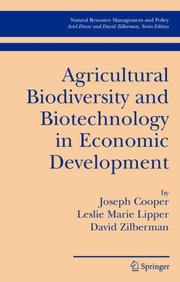
ISBN: 1280608277 9786610608270 0387254099 0387254072 0387254080 Year: 2005 Publisher: New York ; [London] : Springer,
Abstract | Keywords | Export | Availability | Bookmark
 Loading...
Loading...Choose an application
- Reference Manager
- EndNote
- RefWorks (Direct export to RefWorks)
The topics addressed in this book are of vital importance to the survival of humankind. Agricultural biodiversity, encompassing genetic diversity as well as human knowledge, is the base upon which agricultural production has been built, and protecting this resource is critical to ensuring the capacity of current and future generations to adapt to unforeseen challenges. Agricultural biodiversity underpins the productivity of all agricultural systems and is particularly important for poor and food-insecure farmers, who maintain highly diverse production systems in response to the marginal and risky production conditions they operate under. Understanding the importance of agricultural biodiversity in the livelihoods of the food insecure and enhancing its performance through the use of a variety of tools, including biotechnology, is a critically important issue in the world today, where over 800 million people have insufficient food to meet minimum needs. A strong theme that runs throughout the book is the importance of good public policy interventions to promote the provision of public goods associated with agricultural biodiversity conservation and directing biotechnology development to meet the needs of the poor. The book's primary innovation is that it describes the relationship between biotechnology and plant genetic diversity and puts these in the context of agricultural development. Both the conservation of plant genetic diversity and agricultural biotechnology have received extensive examination, but the linkages between the two have not, despite the apparently obvious relationship between the two.
Agrobiodiversity. --- Agricultural biotechnology. --- Agrobiodiversity --- Agricultural biotechnology --- Economic aspects. --- Agro-biotechnology --- Biotechnology --- Agricultural biodiversity --- Agricultural biological diversity --- Agro-biodiversity --- Agricultural ecology --- Biodiversity --- 574.472 --- 631.147 --- 66.098 --- 66.098 Biological processes. Biotechnology --- Biological processes. Biotechnology --- 631.147 Biotechnic, ecological farming (for alternative, intermediate and soft technology). Organic farming and farms --- Biotechnic, ecological farming (for alternative, intermediate and soft technology). Organic farming and farms --- 574.472 Biodiversity --- Economic aspects --- Agricultural economics. --- Environmental economics. --- Biotechnology. --- Agricultural Economics. --- Environmental Economics. --- Chemical engineering --- Genetic engineering --- Economics --- Environmental quality --- Agrarian question --- Agribusiness --- Agricultural economics --- Agricultural production economics --- Agriculture --- Production economics, Agricultural --- Land use, Rural --- Environmental aspects
Book
ISBN: 3540857265 3642099327 3540857273 Year: 2008 Publisher: Berlin ; Heidelberg : Springer-Verlag,
Abstract | Keywords | Export | Availability | Bookmark
 Loading...
Loading...Choose an application
- Reference Manager
- EndNote
- RefWorks (Direct export to RefWorks)
New ideas for new products are not enough for creating successful markets: Product Innovation means to manage the whole chain from invention to new and best selling products in market. This innovation roadmap has to be carefully and systematically planned and procured. There are a lot of methods for creativity, market analysis, evaluation, technology forecast, and decision gates available within this book. These methods and tools are brought together and their scopes of application as well as their limitations are shown. The whole tool kit of methods and decision models like market studies, value engineering, TRIZ or portfolio analysis and others are linked together to the overall Aachen Innovation Model (AIM). This handbook is to be used as an innovation management guide as well as an information source for nearly all methods and tools in the field of innovation for technical products. The complete Innovation Road Map is supported by an interactive, multiple user software tool "EDEN" on an ontology basis (see appendix D in the book). Thus the user has not only access to the collected know how of the past, but can also contribute to growth of expertise within his or her enterprise.
Technological innovations. --- Management --- Business & Economics --- Management Styles & Communication --- Technological innovations --- New products --- Civil & Environmental Engineering --- Engineering & Applied Sciences --- Civil Engineering --- Appropriate technology. --- Management. --- Engineering design. --- Engineering economy. --- Engineering Design. --- Engineering Economics, Organization, Logistics, Marketing. --- Alternative technology --- Appropriate technologies --- Soft technology --- Technology --- Administration --- Industrial relations --- Organization --- Economy, Engineering --- Engineering economics --- Industrial engineering --- Design, Engineering --- Engineering --- Industrial design --- Strains and stresses --- Design --- Engineering economics.
Book
ISBN: 1771993855 1771993847 Year: 2023 Publisher: Athabasca, Alberta : Jon Dron,
Abstract | Keywords | Export | Availability | Bookmark
 Loading...
Loading...Choose an application
- Reference Manager
- EndNote
- RefWorks (Direct export to RefWorks)
In this absorbing volume, Jon Dron views education, learning, and teaching through a technological lens. Focusing on the parts we play in technologies--from language and pedagogies to computers and regulations--Dron posits that individuals are not just users but technical coparticipants.
Education. --- Educational technology. --- Education theory, hard technology, soft technology, educational technology, pedagogy, tool, coparticipation, distributed cognition, extended mind, collective intelligence, complex adaptive system, complexity, complexivism, constructivism, behavourism, philosophy of technology, artificial intelligence, assessment, grades, distance learning, e-learning, online learning, in-person learning, learning environment.
Book
ISBN: 9783319116204 3319116193 9783319116198 3319116207 Year: 2015 Publisher: Cham : Springer International Publishing : Imprint: Springer,
Abstract | Keywords | Export | Availability | Bookmark
 Loading...
Loading...Choose an application
- Reference Manager
- EndNote
- RefWorks (Direct export to RefWorks)
Conservation agriculture—consisting of four components including permanent soil cover, minimum soil disturbance, diversified crop rotations and integrated weed management—is considered the principal pathway to sustainable agriculture and the conservation of natural resources and the environment. In this book leading researchers in the field describe the basic principles of conservation agriculture, and synthesize recent advances and developments in conservation agriculture research. This book is a ready reference on conservation agriculture and reinforces the understanding for its utilization to develop environmentally sustainable and profitable food production systems. The book describes various elements of conservation agriculture; highlights the associated breeding and modeling efforts; analyses the experiences and challenges in conservation agriculture in different regions of the world; and proposes some pragmatic options and new areas of research in this very important area of agriculture. This book is an invaluable source of information for scientists, teachers and students in the fields of agronomy, farming systems, ecology and environmental sciences.
Life Sciences. --- Agriculture. --- Environmental Management. --- Soil Science & Conservation. --- Life sciences. --- Environmental management. --- Soil conservation. --- Sciences de la vie --- Agriculture --- Environnement --- Sols --- Gestion --- Conservation --- Environmental management --- Life sciences --- Soil conservation --- 631.147 --- Biotechnic, ecological farming (for alternative, intermediate and soft technology). Organic farming and farms --- Earth & Environmental Sciences --- Agriculture - General --- 631.147 Biotechnic, ecological farming (for alternative, intermediate and soft technology). Organic farming and farms --- Agricultural conservation. --- Agricultural resources conservation --- Conservation of agricultural resources --- Soil science. --- Agricultural ecology --- Conservation of natural resources --- Environmental protection --- Land use, Rural --- Conservation of soil --- Erosion control, Soil --- Soil erosion --- Soil erosion control --- Soils --- Agricultural conservation --- Soil management --- Environmental stewardship --- Stewardship, Environmental --- Environmental sciences --- Management --- Farming --- Husbandry --- Industrial arts --- Food supply --- Control --- Prevention --- Pedology (Soil science) --- Earth sciences
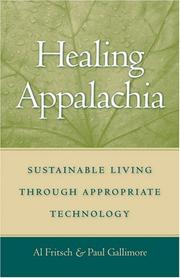
ISBN: 1283233088 9786613233080 0813172179 9780813172170 9780813139005 0813139007 9780813191775 0813191777 9780813124315 081312431X 9781283233088 6613233080 Year: 2007 Publisher: Lexington University Press of Kentucky
Abstract | Keywords | Export | Availability | Bookmark
 Loading...
Loading...Choose an application
- Reference Manager
- EndNote
- RefWorks (Direct export to RefWorks)
Healing Appalachia is the first book to apply ""appropriate technology,"" or the simplest level of technology that can effectively achieve the desired result, specifically to the Appalachian region. The authors examine thirty low-cost, people-friendly, and environmentally benign appropriate technologies that are concerned with such issues as food preservation, land use, shelter, and transportation. They pay close attention to the practicality of each technique according to affordability, ease of use, and ecological soundness. Details on construction and maintenance and resources for locating
Appropriate technology -- Appalachian Region. --- Bioregionalism -- Appalachian Region. --- Environmental protection -- Appalachian Region. --- Green products. --- Sustainable living -- Appalachian Region. --- Appropriate technology --- Sustainable living --- Bioregionalism --- Environmental protection --- Green products --- Earth-friendly products --- Environmentally safe products --- Commercial products --- Green marketing --- Recycled products --- Environmental quality management --- Protection of environment --- Environmental sciences --- Applied ecology --- Environmental engineering --- Environmental policy --- Environmental quality --- Environmentalism --- Human ecology --- Ecological living --- Green living --- Living, Sustainable --- Alternative lifestyles --- Green movement --- Alternative technology --- Appropriate technologies --- Soft technology --- Technology
Book
ISBN: 9814291595 9789814291590 9814291587 9789814291583 Year: 2012 Publisher: Singapore Hackensack, N.J. World Scientific
Abstract | Keywords | Export | Availability | Bookmark
 Loading...
Loading...Choose an application
- Reference Manager
- EndNote
- RefWorks (Direct export to RefWorks)
This book provides a brief overview of the recent trends in innovations. Early inventions/innovations that began in Asia (i.e., compass, paper, gunpowder and printing) spread to the Atlantic (Europe and USA) by land and sea routes. However, with population growth, economic expansion, availability of skilled researchers and lower cost of research in Asia Pacific, there has been a shift in innovation activities in this region. There has been a discernable trend of innovation (R&D) in countries like Japan, Korea, China, India and Singapore. This book attempts to create awareness of this trend and
Technology and state --- Appropriate technology --- Technological innovations --- Economic development --- Development, Economic --- Economic growth --- Growth, Economic --- Economic policy --- Economics --- Statics and dynamics (Social sciences) --- Development economics --- Resource curse --- Breakthroughs, Technological --- Innovations, Industrial --- Innovations, Technological --- Technical innovations --- Technological breakthroughs --- Technological change --- Creative ability in technology --- Inventions --- Domestication of technology --- Innovation relay centers --- Research, Industrial --- Technology transfer --- Alternative technology --- Appropriate technologies --- Soft technology --- Technology --- State and technology --- Endowment of research --- Science and state --- Government policy --- Asia --- Economic conditions. --- E-books --- Internationale economie
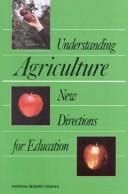
ISBN: 0309039851 0309039878 9786610214464 1280214465 0309567459 0585030731 9780585030739 9780309039871 9780309039857 Year: 1989 Publisher: Washington, D.C. National Academy Press
Abstract | Keywords | Export | Availability | Bookmark
 Loading...
Loading...Choose an application
- Reference Manager
- EndNote
- RefWorks (Direct export to RefWorks)
631.147 --- Agricultural systems --- -Alternative agriculture --- -631.147 Biotechnic, ecological farming (for alternative, intermediate and soft technology). Organic farming and farms --- Biotechnic, ecological farming (for alternative, intermediate and soft technology). Organic farming and farms --- Agriculture --- Agriculture, Alternative --- Alternative agricultural systems --- Alternative farming systems --- Appropriate technology --- Sustainable agriculture --- Farming systems --- Systems, Agricultural --- Systems, Farming --- Agricultural geography --- Farm management --- Case studies --- Secteur agroindustriel --- Agroindustrial sector --- glossaire --- 631.81.036 --- 338.43 <73> --- Landbouweconomie--Verenigde Staten van Amerika. VSA. USA --- Alternative Farming --- Alternative Farming. --- 338.43 <73> Landbouweconomie--Verenigde Staten van Amerika. VSA. USA --- Agriculture / Sustainable Agriculture --- farming systems --- resource management --- Regional planning --- Animal production --- Plant production --- Organic agriculture --- Évaluation --- evaluation --- research --- Economic development --- Alternative agriculture --- glossary --- USA --- 631.147 Biotechnic, ecological farming (for alternative, intermediate and soft technology). Organic farming and farms --- 338.43 --- 63 --- (73) --- $?$90/05 --- Case studies. --- Basic Sciences. Agriculture --- TECHNOLOGY & ENGINEERING --- evaluation. --- Pests --- Integrated control --- Animal pests --- Pest animals --- Vermin --- Organisms --- Biology, Economic --- Zoology, Economic --- Alternative agriculture - United States. --- Agricultural systems - United States - Case studies. --- Farming methods --- Modern production --- National research council --- Usa
| Listing 1 - 10 of 14 | << page >> |
Sort by
|

 Search
Search Feedback
Feedback About UniCat
About UniCat  Help
Help News
News